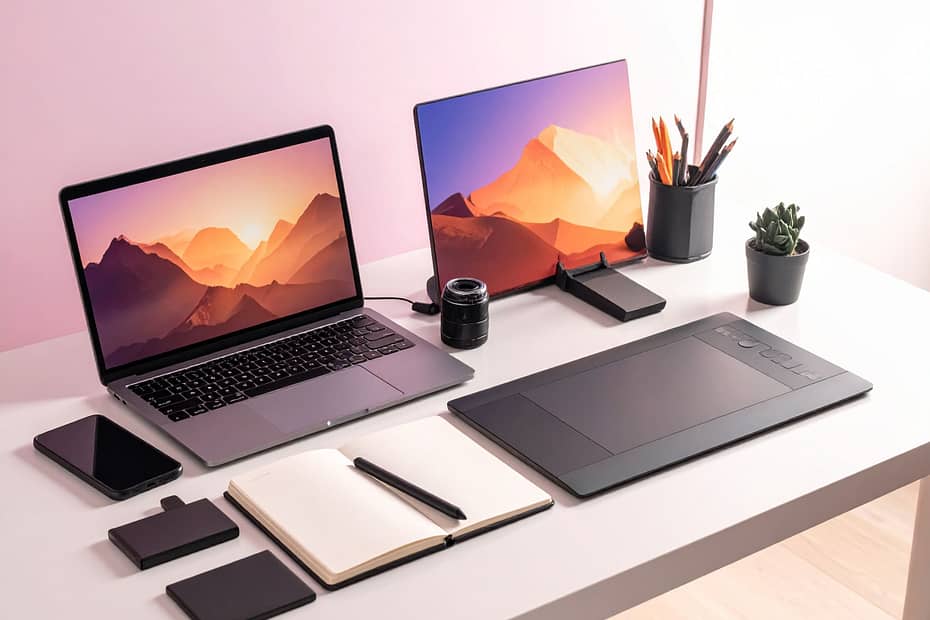Designers who want to create graphics resources, creators who create video, social media video, writers, students who want to build projects, professionals doing office work, or freelancers need some kind of equipment to create. For example, graphic designers and creators require proper tools to create graphic resources, and video editors need a reliable laptop. Photographers also require the right gear. Without good equipment, it’s hard to produce high-quality work or use your full potential.
Having the right equipment helps you create quality content faster, saves time, and reduces extra effort. It also makes the creative process smoother—you can focus more on ideas instead of fighting with slow or unreliable tools.
But how do you decide which equipment you really need? Which gear will actually help you create better content? Different levels of designers need different setups. If you’re a beginner, what should you start with? And if you’re already experienced, what upgrades make sense?
In this post, we’ll talk about the essential gear you should have for your design work and how to choose the right tools for your level.
Core Devices
At the heart of every creative workspace is a capable computer. Beginners can start with a solid laptop or desktop that has at least 8 GB of RAM, an Intel i5 or Ryzen 5 processor, and SSD storage for faster performance. Something as simple as a MacBook Air, a Dell XPS, or an HP Pavilion is enough for graphic design, light video editing, or digital art when you’re starting out. A decent smartphone with a good camera is also handy for capturing quick ideas or taking reference photos.
As your projects grow more complex, a high-performance computer becomes important. Aim for 16 GB of RAM, a dedicated graphics card, and a fast processor to run heavier programs like Adobe Creative Cloud, Blender, or other 3D tools. Many intermediate creators also add a drawing tablet or an iPad with a stylus—such as the iPad Pro with Apple Pencil or a Wacom tablet—for sketching, illustration, and more natural design work.
Professionals often move to even more powerful machines: a MacBook Pro with the latest M-series chips or a custom-built desktop with an RTX GPU and 32 GB or more of RAM. Multiple monitors are common at this stage, offering more screen space for editing timelines or reference images. Dedicated drawing displays like the Wacom Cintiq or Huion Kamvas provide unmatched precision for digital art.
Key Accessories and Equipment
Beyond the main computer, accessories make a big difference. External hard drives or portable SSDs keep backups safe and free up storage. A high-quality monitor with accurate color reproduction—ideally an IPS display with 100 % sRGB or Adobe RGB coverage—is crucial when you care about how your designs look in print or online. Good peripherals matter too: a comfortable mechanical keyboard, a precise mouse, or a pen tablet can reduce strain and improve control during long sessions. For those working with color-critical projects, a color calibration tool ensures that what you see on screen matches the final output.
Software and Digital Tools
Your creative power depends heavily on the software you use. For graphic design, Adobe Photoshop and Illustrator remain industry standards, while Affinity Designer or CorelDRAW are strong alternatives. Video editors often rely on Adobe Premiere Pro, Final Cut Pro, or DaVinci Resolve. For 3D modeling and motion graphics, Blender and Cinema 4D are popular choices, with After Effects for animation. If you’re on a budget, free tools like GIMP, Inkscape, or Krita are surprisingly capable. Cloud storage services such as Google Drive, Dropbox, or OneDrive make it easy to back up work and share files with clients or collaborators.
Extensions and Plugins
Small add-ons can save hours of time. Photoshop users often enhance their workflow with plugins like the Nik Collection or ON1 Effects for advanced filters and retouching. Browser extensions such as ColorZilla for quick color picking, WhatFont to identify typefaces, or Loom for screen recording help designers and creators research and communicate ideas. Figma and Illustrator also have rich ecosystems of plugins and add-ons—think Icons8 libraries or custom brushes—that keep your toolkit flexible.
Optional but Helpful Gear
Depending on your creative niche, certain extras can take your work to the next level. Photographers and content creators often invest in a good camera—DSLR or mirrorless—along with softbox or ring lights for consistent lighting. Podcasters, streamers, or video editors benefit from a high-quality microphone like the Blue Yeti or Rode NT-USB and a reliable pair of studio headphones, such as those from Audio-Technica headphones. An ergonomic chair and adjustable desk setup are not luxuries; they protect your posture and comfort during long hours.
Choosing the Right Setup
The most important thing to remember is that you don’t need every piece of equipment on day one. Start small and make the most of what you have. Many beginners create impressive work with just a laptop and free software. Upgrade gradually as your skills grow and as you take on projects that demand more power. Quality matters more than quantity—reliable gear lasts longer and ultimately saves money.
Conclusion
The right devices and tools won’t create ideas for you, but they will make it easier to bring those ideas to life. Whether you are just starting with a budget laptop or building a full professional studio, choose equipment that fits your needs and leaves room to grow. Your creativity is the real engine; the right setup simply lets it run at full speed.
